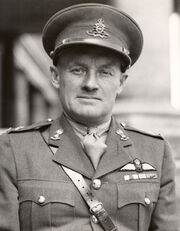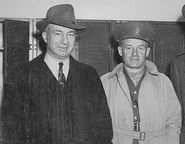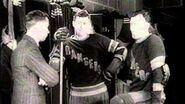
Conn Smythe in uniform as a Canadian Artillery Major.
Constantine Falkland Cary Smythe (February 1, 1895 – November 18, 1980) was a Canadian builder in the National Hockey League. He is best known as the principal owner of the Toronto Maple Leafs from 1927 to 1961 and as the builder of Maple Leaf Gardens. As owner of the Leafs during numerous championship years, his name appears on the Stanley Cup eight times: 1932, 1942, 1945, 1947, 1948, 1949, 1951, and 1962.
Biography[]
Early Years[]
Born on February 1, 1895, in Toronto, Smythe went to high school at Upper Canada College (until his father, a journalist, could no longer afford the tuition) and Jarvis Collegiate. His parents were Albert Smythe, an Irish Protestant from County Antrim who emigrated to Canada in 1889, and Amelia Constantine. He began engineering studies at the University of Toronto in the fall of 1912. There he played hockey as a centre, leading the Toronto Varsity Blues to the finals of the 1914 Ontario Hockey Association junior championships and to the OHA junior championship the following year. The coach of the losing team in 1915 was Frank Selke , who years later would work for Smythe at Maple Leaf Gardens.
Serves in the First World War[]
The First World War interrupted his studies. A week after winning the OHA championship in March 1915, Smythe and his eight teammates enlisted. Smythe would recall that they tried to enlist at the beginning of the 1914–15 season, but were told to come back when they had beards. After securing a provisional rank of lieutenant with the 2nd (Ottawa) Battery, 8th Brigade, on July 17, he headed to the Royal School of Artillery in Kingston, Ontario, in August for five weeks of training. He made full lieutenant on September 11, and was able to get himself transferred to the 40th (Sportsmen's) Battery of Hamilton, organized by publishing figure Gordon Southam, son of William Southam. The unit, with Smythe as team manager, organized a team to compete in the Ontario Hockey Association's senior league—one of four Toronto-based teams in the league in 1916. He played one game at centre, and then decided to replace himself with a better player. The team didn't complete the season, as the 40th Battery went overseas in February 1916. On March 5, 1917, Smythe was awarded the Military Cross for "dispersing an enemy party at a critical time. Himself accounted for three of the enemy with his revolver." After the death of his commanding officer, Major Gordon Hamilton Southam, Smythe transferred to the Royal Flying Corps in July 1917. One of his instructors was Billy Barker, who would later become the first president of the Toronto Maple Leafs. He served as an airborne observer, directing artillery fire. Smythe was shot down by the Germans and captured on October 14, 1917. He was imprisoned by the Germans at Schweidnitz (Swidnica) in Upper Silesia. He made two failed escape attempts and ended up in solitary confinement as a result. He was a POW until the end of the war.
Builds the New York Rangers[]
Following the war, Smythe returned to Toronto and became a partner in paving business which soon expanded into sand and gravel. He went back to U of T and graduated with a civil engineering degree in 1920 and was married during the school year. Smythe and his business partner split, with Smythe getting the sand and gravel business. In the evenings, he was a hockey coach, and occasionally took U of T teams to the Boston area for games against colleges from that area. In 1926, Charles Adams, owner of the Boston Bruins, recommended him to Col. John S. Hammond, representing the owners of the new New York Rangers franchise, who was looking for someone to build his team. Smythe was hired as general manager and coach. But on 27 October 1926—before the Rangers had played a single regular season game—Smythe was fired by Hammond in favour of Lester Patrick. Smythe believed that he lost his job by refusing to sign two-time NHL scoring champion Babe Dye, despite Hammond's wishes. Dye would go on to score just one more goal in his NHL career before retiring. Publicly, Hammond and Smythe said the parting was on good terms and was because Smythe could not be away from his sand and gravel business in the summers. The Rangers would win the Stanley Cup in 1928 – only their second year of existence – largely with the players Smythe had brought to the team.
Smythe returned to Toronto and offered to coach the Toronto St. Pats, but was rejected in favour of Mike Rodden. Instead, he coached the Toronto Varsity Grads to the Allan Cup. The team went on to win the gold medal at the 1928 Olympics in St. Moritz the following year. Smythe refused to go because two Varsity Blues players he had promised could be part of the team were blocked by what Smythe described as a "pressure play" from two Grads players to get relatives placed on the team instead.
Smythe and the Maple Leafs[]
Bitter over his dismissal by the Rangers, on February 14, 1927, Smythe took his severance pay—boosted by some gambling winnings—and with the help of some partners bought the Toronto St. Pats for $160,000 (J. P. Bickell, whose shares were valued at $40,000, kept his stake in the team, while Smythe and his partners bought out the other shareholders). The team was renamed the Toronto Maple Leafs and played the rest of the season under the new name. St. Pats owner Charlie Querrie had been mulling a larger bid from a Philadelphia group, but Smythe persuaded him that civic pride was more important than money.
Although Smythe was the largest shareholder, his name was initially kept in the background. However, when the Leafs promoted a public share offering to raise capital, it announced that "one of the most prominent hockey coaches in Toronto" would be taking over management of the club. That prominent coach turned out to be Smythe. He succeeded Querrie as the team's governor, and installed himself as general manager. The next season, Smythe changed the team's colours from green and white to their present blue and white. While he claimed that the blue stood for the Canadian skies and the white for snow, it has been a long-standing tradition that top-level Toronto teams wear blue. At the start of the next season Smythe took over as coach as well. For the next three years, he was a one-man band as governor, general manager and coach.
Before the 1931–32 NHL season, Smythe led the construction of Maple Leaf Gardens. In its first season in the new building, the franchise won its first Stanley Cup as the Maple Leafs. As part of a corporate reorganization, the Leafs became the leading subsidiary of the newly created Maple Leaf Gardens Ltd.; Smythe remained the largest shareholder.
WWII Service[]
In the Second World War, at age 45, Smythe again served in the Canadian Army. Initially, he was a captain in charge of a troop within the Canadian Officers Training Corps, based at the University of Toronto. In 1941, he formed the 30th Battery—a sportsmen's anti-aircraft battery that was part of the 6th Light Anti-Aircraft Regiment of the Royal Canadian Artillery. Smythe was made acting major and Officer Commanding. He was offered a higher rank to become the army's sports officer, but turned it down. After being stationed in England for nearly two years, Smythe and his unit were sent to France in July 1944, where within three weeks he was badly wounded when the Germans bombed an ammunition depot. For the rest of his life he would walk with a limp and suffer bowel and urinary tract problems. He was sent back to Canada in September on a hospital ship. Smythe then became a vocal critic of government policy that made overseas service voluntary, and was threatened with a court martial.
Becomes majority owner of the Leafs[]
In the fall of 1940, Smythe had made former team captain Hap Day, who had also become partner in the sand and gravel business—the new coach of the Leafs, replacing the Leafs' coach since 1931, Dick Irvin. A committee, headed by Ed Bickle, Bill MacBrien and Selke ran Maple Leaf Gardens Ltd.
Upon his return from the military, Smythe found himself in the middle of a power struggle over the presidency of Maple Leaf Gardens Ltd. Smythe suspected that MacBrien, a member of the board of directors, wanted to succeed Bickle as president and give Smythe's job to Selke, who had been acting general manager in Smythe's absence. Smythe wanted to be president and asked Selke for his support. Selke equivocated, and relationship between the two longtime friends turned acrimonious, leading to Selke's resignation in May 1946. Two months later, he became manager of the Montreal Forum and head of hockey operations for the Montreal Canadiens.
With the support of J. P. Bickell and with the help of a $300,000 loan from Toronto stockbroker and Gardens shareholder Percy Gardiner, Smythe was able to buy enough stock to become majority shareholder of Maple Leaf Gardens Ltd. He was thus able to install himself as president of the Gardens on November 19, 1947..
Smythe oversaw one of hockey's greatest dynasties when Toronto won six Stanley Cups in 10 seasons between 1942 and 1951. Hap Day coached the team to five of those Cups and was assistant general manager for the sixth. Smythe was named in a poll of Canadian sports editors the "most dominating personality in any capacity in sports" for 1949. Notably, only two of these teams finished first overall, and one barely made the playoffs with a record three games under .500. However, Smythe was known for caring little about gaudy regular season records. From the 1940s onward, his two mantras to Leafs teams were to make the playoffs and keep the turnstiles clicking at Maple Leaf Gardens. In part because of this, the Leafs did not post a 100-point season until 1999–2000, 20 years after Smythe's death.
However, the Leafs spent most of the 1950s as a mediocre team, struggling under three different coaches while Day remained assistant general manager under Smythe. Even so, in 1955, Smythe turned over most responsibility for hockey operations to Day, but nominally remained general manager. However, just after the Leafs were eliminated from the playoffs in 1957, Smythe told the media that it had been "a season of failure" and that he didn't know if the 55-year-old Day would be available for the next season. It was a public rebuke that triggered the response Smythe wanted: Day resigned.
In March 1957, Smythe resigned as general manager and turned the operation of the hockey team over to a seven-person committee, headed by his son, Stafford Smythe. Newspaper owner John Bassett was another member of the committee, which became known as the Silver Seven, as was Percy Gardiner's son, George Gardiner. Initially, all members were in their 30s or early 40s, but that changed before the end of the year when 54-year-old Harold Ballard, president of the Toronto Marlboros, was appointed to the committee to fill a vacancy.
Sells to his son and partners[]
Though the committee made most decisions involving the Leafs, Smythe was not a hands-off owner and was constantly fighting with his son. After four years, he offered to sell his shares to Stafford and in November 1961, Smythe sold 45,000 of his 50,000 shares in Maple Leaf Gardens Ltd. to a partnership of his son, Ballard, and Bassett for $2.3 million--a handsome return on his investment of 34 years earlier. Smythe would later claim that he thought he was selling the company only to his son, but there is skepticism that he could have believed that Stafford could have come up with the millions of dollars needed to purchase the shares on his own.
Smythe remained chairman of the board until 1964, when Bassett succeeded him. In March 1966, Smythe sold his remaining shares and resigned from the board of directors after a Muhammad Ali boxing match was scheduled for the Gardens. He found Ali's refusal to serve in the U.S. Army in the Vietnam War to be offensive and said that by accepting the fight, Gardens owners had "put cash ahead of class.
Other Accomplishments and Honours[]
Smythe supervised the construction of the Hockey Hall of Fame building in Toronto in 1961. He served as the Hall's chairman for several years, but resigned in June 1971 when Busher Jackson was posthumously elected into the Hall. In his letter of resignation, Smythe said that induction to the Hall was supposed to be reserved for people with "integrity and character" and that Jackson's admission showed those standards were being ignored.
The National Hockey League honoured Smythe's contribution to the game by introducing the Conn Smythe Trophy in 1965, to be presented to the Most Valuable Player in the Stanley Cup playoffs. After his death, the trophy was renamed the Conn Smythe Memorial Trophy. The league also named one of its four divisions, the Smythe Division, after him prior to the 1974–75 season.
Smythe died on November 18, 1980 in Caledon, Ontario at the age of 85.
Coaching Record[]
| Team | Year | Regular Season | Post Season | ||||||
|---|---|---|---|---|---|---|---|---|---|
| G | W | L | T | OTL | Pts | Finish | Result | ||
| TOR | 1927–28 | 44 | 18 | 18 | 8 | - | 44 | 4th in Canadian | Did Not Qualify |
| TOR | 1928–29 | 44 | 21 | 18 | 5 | - | 47 | 3rd in Canadian | Lost in Second Round |
| TOR | 1929–30 | 44 | 17 | 21 | 6 | - | 40 | 4th in Canadian | Did Not Qualify |
| TOR | 1930–31 | 2 | 1 | 0 | 1 | - | (53) | 2nd in Canadian | (resigned) |
Gallery[]
Video[]
Arguably the most interesting NHL video of the 1930's. 1933 Stanley Cup Finals Game 4 highlights of all periods of play including the Cup winning goal by Bill Cook in overtime. Foster Hewitt provides the play-by-play and interviews Conn Smythe, Dick Irvin, Busher Jackson, Charlie Conacher, King Clancy and Red Horner in the dressing room during the first intermission. Horner played with a broken right hand and shows Hewitt his cast and how he was able to grip his stick. Hewitt then interviews the Rangers in their dressing room in the second intermission.
| Preceded by Charles Querrie |
Principal owner, Toronto Maple Leafs 1927-1961 |
Succeeded by Stafford Smythe, Harold Ballard, and John Bassett |
| Preceded by Charles Querrie |
General Manager of the Toronto Maple Leafs 1927-1957 (shared with Hap Day from 1955-1957) |
Succeeded by Stafford Smythe (de facto) |
| Toronto Maple Leafs Head Coaches | |
|---|---|
| ARENAS: D. Carroll • ST. PATS: Heffernan • Sproule • F. Carroll • O'Donoghue • Querrie • Powers • Querrie • Rodden • MAPLE LEAFS: Romeril • Smythe • Duncan • Smythe • Irvin • Day • Primeau • Clancy • Meeker • Reay • Imlach • Clancy • McLellan • Clancy • Kelly • Neilson • Smith • Duff • Imlach • Crozier • Nykoluk • Maloney • Brophy • Armstrong • Carpenter • Watt • Burns • Beverley • Murphy • Quinn • Maurice • Wilson • Carlyle • Horachek • Babcock • Keefe | |
| This page uses content from Wikipedia. The original article was at Conn Smythe. The list of authors can be seen in the page history. As with Ice Hockey Wiki, the text of Wikipedia is available under the Creative Commons Attribution-Share Alike License 3.0 (Unported) (CC-BY-SA). |


